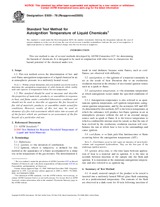Wir benötigen Ihre Einwilligung zur Verwendung der einzelnen Daten, damit Sie unter anderem Informationen zu Ihren Interessen einsehen können. Klicken Sie auf "OK", um Ihre Zustimmung zu erteilen.
ASTM E659-78(2005)
Standard Test Method for Autoignition Temperature of Liquid Chemicals
Automatische name übersetzung:
Standard -Testverfahren für die Selbstentzündungstemperatur von flüssigen Chemikalien
NORM herausgegeben am 15.9.2005
Informationen über die Norm:
Bezeichnung normen: ASTM E659-78(2005)
Anmerkung: UNGÜLTIG
Ausgabedatum normen: 15.9.2005
SKU: NS-47553
Zahl der Seiten: 6
Gewicht ca.: 18 g (0.04 Pfund)
Land: Amerikanische technische Norm
Kategorie: Technische Normen ASTM
Die Annotation des Normtextes ASTM E659-78(2005) :
Keywords:
ICS Number Code 13.300 (Protection against dangerous goods), 71.040.40 (Chemical analysis)
Ergänzende Informationen
| Significance and Use | ||||||
|
Autoignition, by its very nature, is dependent on the chemical and physical properties of the material and the method and apparatus employed for its determination. The autoignition temperature by a given method does not necessarily represent the minimum temperature at which a given material will self-ignite in air. The volume of the vessel used is particularly important since lower autoignition temperatures will be achieved in larger vessels. (See Appendix X2.) Vessel material can also be an important factor. The temperatures determined by this test method are those at which air oxidation leads to ignition. These temperatures can be expected to vary with the test pressure and oxygen concentration. This test method is not designed for evaluating materials which are capable of exothermic decomposition. For such materials, ignition is dependent upon the thermal and kinetic properties of the decomposition, the mass of the sample, and the heat transfer characteristics of the system. This test method can be employed for solid chemicals which melt and vaporize or which readily sublime at the test temperature. No condensed phase, liquid or solid, should be present when ignition occurs. This test method is not designed to measure the autoignition temperature of materials which are solids or liquids at the test temperature (for example, wood, paper, cotton, plastics, and high-boiling point chemicals). Such materials will thermally degrade in the flask and the accumulated degradation products may ignite. This test method was developed primarily for liquid chemicals but has been employed to test readily vaporized solids. Responsibility for extension of this method to solids of unknown thermal stability, boiling point, or degradation characteristics rests with the operator. |
||||||
| 1. Scope | ||||||
|
1.1 This test method covers the determination of hot- and cool-flame autoignition temperatures of a liquid chemical in air at atmospheric pressure in a uniformly heated vessel. Note 1—Within certain limitations, this test method can also be used to determine the autoignition temperature of solid chemicals which readily melt and vaporize at temperatures below the test temperature. 1.2 This standard should be used to measure and describe the properties of materials, products, or assemblies in response to heat and flame under controlled laboratory conditions and should not be used to describe or appraise the fire hazard or fire risk of materials, products, or assemblies under actual fire conditions. However, results of this test may be used as elements of a fire risk assessment which takes into account all of the factors which are pertinent to an assessment of the fire hazard of a particular end use. |
||||||
| 2. Referenced Documents | ||||||
|
Empfehlungen:
Aktualisierung der Gesetze
Wollen Sie sich sicher sein, dass Sie nur die gültigen technischen Vorschriften verwenden?
Wir bieten Ihnen Lösungen, damit Sie immer nur die gültigen (aktuellen) legislativen Vorschriften verwenden könnten.
Brauchen Sie mehr Informationen? Sehen Sie sich diese Seite an.




 Cookies
Cookies
